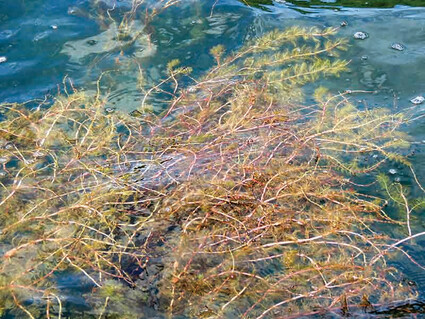Invasive plants task force prepares for 2023 season
May 18, 2023

File photo
A patch of Eurasian Watermilfoil grows in the Noxon reservoir. The Sanders County AIP task force treats milfoil each year.
As boaters and recreationists prepare for the 2023 summer season on the Clark Fork River, so is the Sanders County Aquatic Invasive Plants (AIP) task force. The task force oversees treatment of invasive species on the Noxon and Cabinet Gorge reservoirs.
Kim McMahon is the principal investigator with Pinnacle Research and Consulting out of Plains. She said that since 2017, the task force has been focusing on keeping main access ways clear of the invasive species Eurasian Watermilfoil (EWM). "We are seeing good results and have good luck with the products we're using," McMahon said. She added that public boat launches on the Cabinet Gorge and Noxon reservoirs are the highest priority, and then shoreline areas with private dock access.
The task force has a goal of the last week of July or first week of August for applying herbicides to treat EWM. At that point in the summer, the plants have grown up enough for treatment but are not interfering with boats and other recreation activities. "We have had a lot of success in keeping the access ways clear," McMahon expressed. The task force is grant funded, but receives support from partners including Avista and FWP. McMahon said Avista supports AIP efforts through the Clark Fork Settlement Agreement. "Avista helps support the program each year with treatment and to keep the program running and we appreciate their support."
In 2022, the task force treated 49 acres in Noxon and had an injury rate of 90% or better in seven of the eight plots six weeks after treatment, McMahon stated. In 2021, 64 acres were treated in Noxon with an injury rate of 95% or better in six of the seven treatment plots six weeks post-treatment.
Prior to treatment, Montana Fish, Wildlife & Parks (FWP) staff will go out on the reservoirs and conduct a pre-treatment survey in July. FWP will survey all known access areas to determine where the dense populations of EWM occur. That information is then relayed to the county's task force, who will decide what areas will get treated later in the summer. McMahon said the goal is to treat 60-80 acres this year. Treatment normally takes one-two days.
Before the change in strategy, the task force was working toward the goal of eradicating EWM, treating 100-200 acres each year. "It got to the point that it didn't seem realistic that eradication was possible," McMahon said, due to the cost of treatment and the size of the areas.
McMahon said that last year, the task force heard from some landowners about problems with EWM around their docks. The task force is looking at those areas this year. She also noted that there has been so much turnover in property ownership in the last few years that the task force is reaching out to land owners on both reservoirs to let them know about resources that are available. "We'll help them understand the options for treatment," she said. Land owners can install bottom barriers in the water near their property, or they can rake the weeds out and dispose of them. McMahon added that it's important to not throw the weeds back in the river. She said the bottom barriers are a good option for keeping plants at bay around docks, as they cover the vegetation so it can't grow up.

"There is a common misconception about EWM," McMahon stated. "People see vegetation in the water and automatically assume it should be treated and removed, but native plants are actually beneficial for the system. If removed, that leaves an opportunity for invasive species to move in."
She added that it's important for everyone to do their part in preventing the transport of invasive species. In Thompson Falls, a boat check station helps prohibit the spread of invasive species. In 2021, the Thompson Falls check station completed 4,346 inspections. It was open from April 23 to September 19. Of those, 1,034 were out-of-state visitors and 3,312 were Montana residents. The local check station found 12 instances of vegetation and 26 boats with standing water. Two boats were determined to be dirty, crusty or slimy by the check station staff. The items classified at the check stations determine a boat to be high-risk, according to FWP, meaning it is more likely to be carrying adult or larval mussels, aquatic weeds or other aquatic invasive species.
The number of boats through the check station in 2022 was up, with 4,923 inspections. Last year, check station staff found two instances of animals on boats, 45 boats with vegetation, 36 had standing water, seven were determined dirty, crusty or slimy, and one boat was carrying illegal bait. Of the 4,923 inspections between April 23 and September 18 last year, 4,037 of them were for Montana residents.
"The check stations are really important," said McMahon. "It's nice that we have the boat check station here because with a lot of bass tournaments on the Noxon Reservoir there is a lot of traffic coming and going." She said that anything that goes in the water, including waders, should be checked for fragments of plants and properly cleaned. McMahon also explained that the Forest Service has a decontamination plan for fighting wildfires. The program is in place to ensure equipment is decontaminated so they aren't transporting invasive species. She noted that FWP has a similar program for their water activities.
McMahon said that in 2024, the AIP task force will convene a scientific advisory panel for input and plan to do a reservoir-wide survey of invasive species. She said FWP will go through the entire Cabinet and Noxon reservoirs to see what the system is like and how it's changing. "That will determine whether we need to re-examine our approach," she explained. For more information, visit http://www.sanderscountyais.com.



Reader Comments(0)